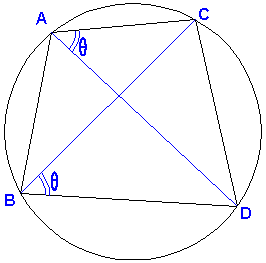Ptolemy via Cross-Ratio
Mariano Perez de la Cruz
September 9, 2011
Recollect two well known properties of the cross-ratio.
- Given four points on a plane if cross-ratio value (ABCD) = m, them the cross-ratio value, obtained by permutation the two interior points B and C,
(ACBD) = 1 - m. - If complex numbers a, b, c, d represent points A, B, C and D, then the four points A, B, C, and D all belong to a same circle (or a straight line) iff the cross-ratio (abcd) is a real number.
For example, the cross-ratio (abcd) is the quotient of two single ratios
(acd) = (a - c)/(a - d) = (|a - c|/|a - d|) eθ = La,
(bcd) = (b - c)/(b - d) = (|b - c|/|b - d|) eθ = Lb.

Indeed both arguments have the same value; we see the segment DC under the same angle θ either from A or B, as long as A, B, C and D are concyclic and A and B lay on the same side of segment CD. Therefore the quotient La/Lb of the two numbers La and Lb with the same arguments is real and equal to the ratio of their moduli, |La|/|Lb|. As a consequence, (ABCD) = (abcd), whenever points A, B, C, D are concyclic (or collinear) and the pairs {A, B} and {C, D} do not separate each other. In addition, in all eligible cases,
The same procedure applies to the other cross-ratio (ACBD), and we see that also
Ptolemy's theorem is just a direct consequence of the above and is equivalent to
(ABCD) + (ACBD) = 1.
Indeed, if we express the sides and the diagonals of the quadrilateral ABCD as the moduli of the related complex numbers:
AC·BD / AD·BC + AB·CD / AD·BC = 1,
which is exactly Ptolemy's identity.
Ptolemy's Theorem
- Ptolemy's Theorem
- Sine, Cosine, and Ptolemy's Theorem
- Useful Identities Among Complex Numbers
- Ptolemy on Hinges
- Thébault's Problem III
- Van Schooten's and Pompeiu's Theorems
- Ptolemy by Inversion
- Brahmagupta-Mahavira Identities
- Casey's Theorem
- Three Points Casey's Theorem
- Ptolemy via Cross-Ratio
- Ptolemy Theorem - Proof Without Word
- Carnot's Theorem from Ptolemy's Theorem
|Contact| |Front page| |Contents| |Geometry| |Up|
Copyright © 1996-2018 Alexander Bogomolny
73579470
